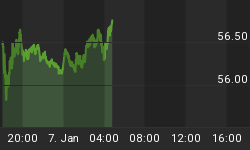What if market forces finally make the perma-bears right?
Precious Metals
For the precious metals community the ultimate catastrophe would have the US dollar going to "zero". Of course, what is not part of this equation is what happens if industrial commodities rise much faster than the price of gold or silver. This has happened a number of times and the result has been gold mining costs rose faster that bullion prices and the industry lost profitability.
Perhaps there could be a time when the dollar plunges and only gold and silver go up. Dream on!
As we have noted, to become really famous in this sector, one has to come up with a gold target of at least $10,000. We haven't even tried to become half-famous. Nevertheless, gold's real price (deflated by the PPI) has been going up since December, indicating improving profitability. This has ended the long decline that began as the mania blew out in 2011. Last November we concluded that a cyclical bull market for the sector was possible.
The previous bull market for silver drove the price from 8.40 in November 2008 to over 49 in April 2011. And as Bob Moriarity ironically pointed out, most of the silver bugs were claiming that governments were deliberately suppressing the price. Like smoking marijuana, too much supply/demand research does weird things to your head.
Such as passionately tout that the next plunge in the dollar would be catastrophic. No! The great contractions have occurred with a strong senior currency. As policy, currency depreciation has been the best remedy for any condition. The worst thing that can happen is an outbreak of sound money.
Our wrap on this side of the equation is that the dollar goes down and asset prices go up. Fun stuff when financial assets really get inflated as with junk bonds and stock prices. That's until they reach technical excesses and start to deflate. The dollar is now poised for a strong rally.
Policymaking
Policymakers propose and markets dispose.
The problem is that the main tools of intervention have been inspired by some intellectual being personally offended by a contraction and intuitively inventing a fix. Two come to mind: Misselden during the contraction that began in 1618; and Keynes in the contraction that began in 1929. It is safe to say the neither knew about each other.
The financial world is not always vulnerable to a severe contraction. But the main thrust of policymaking since the early 1930s has been that any financial hit could precipitate a severe contraction. Actually, inspired intrusion began following the great commodity bust of 1920-21. The Fed was fearful that failure was at hand and through the 1920s provided easy monetary conditions. Central bankers did not understand that when a great commodity boom completes and crashed it set up a mania in financial assets.
The pattern repeated with the commodity collapse that began in 1980, setting up this era of financial asset inflation. So, the Fed's belief that any recession will lead to a great collapse has unwittingly inspired a series of bubbles that will eventually resort to the mean.
It could be brutal. It could be instructive to the policymaking community. More important, it could inspire the general public to constrain the experiment in intrusive central banking.
Why call something as established as central banking an experiment?
Misselden wrote a brief line that essentially said that throwing credit from somewhere would make a credit contraction go away. This "wisdom" was also revealed to John Law in the early 1700s and well as to Walter Bagehot, the esteemed editor of The Economist in 1873. That was at the peak of that bubble and the beginning of a twenty-year contraction. UK economists in 1884 began calling it the Great Depression.
The tout by those who formed the Fed in 1913 was that it would prevent the financial hits that pushed off a recession. There has been 19 recessions since the Fed opened its doors in 1914.
Not just an experiment, but a failed one.
Will the perma-bears in the general stock markets be correct?
Possibly recognized by the first quarter.
What would be the "killer" for perma-bulls and central bankers?
In all five of the great post-bubble contractions, the senior currency has been firm against most other currencies and commodities, for most of the time. This makes debt service into the financial capital in senior currency units chronically difficult.
A classical bubble completed in 2007 and the dollar has been firmer than most gold bugs and central bankers would expect. This will provide a double irony. Both are ardent that the Fed can depreciate the dollar at will.
Markets choose what will happen, not policymakers.















